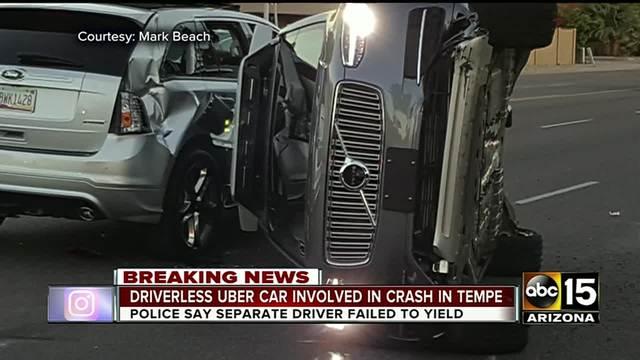Those of us who pay attention to self-driving car news have surely heard of Uber’s crash in Arizona, which I believe is the most spectacular looking for an autonomous vehicle to date (excluding very nasty misadventures with inattention and Tesla’s autopilot).

I chose this image because the local news brilliantly captioned it with all one needs to know and a superb unintentional pun.
My first thought is that this looks bad. Come on, the thing’s on its side! Problems and things not going well, even a crash, are to be expected, but to get a car to do this is not exactly easy. I’m extremely curious how that could even have happened. Is the software capable of effecting a combination of responses that can roll a car over? If so, why? Did it need the other cars involved to push it over? Or am I being pessimistic? Perhaps it did such an evasive life-saving move that it drove on two wheels for a while like in a Hollywood stunt. I doubt that though. So that’s question number one - how does an autonomous vehicle even get software that could put it on its side? A related question I guess is why are they choosing vehicles with centers of gravity high enough for this to happen?
Some people I respect seem to think Uber is very, very naughty. (JWZ for example.) I think citing this crash as evidence of their naughtiness is probably not going to make that case very well. I don’t use Uber and don’t know enough about them to have strong opinions about their corporate citizenship, but this crash looks like a day in the life of autonomous vehicle development. Although to me it definitely does look like a day that should have been foreseen in a simulator. If they’re looking for someone to help calibrate their simulator with their real cars, I know someone who is interested in such things.
Another interesting idea I had that this event inspired was that I think it should be safe to end the silly restriction on driving while under the influence of alcohol. I have never been an alcohol drinker and drunk drivers were once literally my greatest predator (joined now by two new super-predators, Android and iPhone). But think about it. Why can people not drink several bottles of scotch and then go joy riding in a very dangerous high-energy automobile? Because usually, they’re going to drive terribly. But what if they don’t? Seems a bit unfair to use this causation equals correlation argument here. If your cultural first world upbringing of the last fifty years makes you balk at that suggestion, consider the new problem of people driving under the influence of recently legalized substances which can not be conveniently tested for.
My point here is that why you’re driving like an idiot is no longer necessary to infer that you are likely to be driving like an idiot. Today we can have so many sensors and sophisticated AI that it should be possible to have cars that shutdown when you do drive like an idiot, and here’s the important part, for any reason. I don’t care what weird drugs you just took or how you’re busy with your very important social media life; I just want you off the damn road!
This crashed Uber car reminds us that no breathalyzer or sobriety tests will ever be needed in the future. A jury can just look at the evidence of exactly what the car was doing since its driver left the bar and decide if they were driving badly. This is one of those subtle but big changes in perspective that these new technologies are bringing. I could envision, for example, a company that creates a product that can detect impaired driving behavior and locks out a car or rats on the driver. This could be useful for parents and probation officers, etc.
Right now, I’d just like to see a more complete report about what exactly happened in this accident. One thing we can be completely sure about is that such a report exists!
Update: An extremely competent civil engineer points out that rollovers come in two categories - tripping and not. The tripping ones are much easier from a physics standpoint. This Wikipedia article talks all about it (and proves there are some pretty odd articles). I still think that’s not much of an excuse; the car should be aware of tripping hazards like curbs and know to avoid them. But further down in that Wiki page is a table called "General list of roll-over risk". What caught my eye is that number six is a Volvo XC90. If that car seems familiar it’s because it’s the one in the crash! (Bloomberg confirms.) And you don’t do the rollover mechanics any favors by bolting on a gangly lidar mast. Choose your install point for that mini supercomputer wisely!